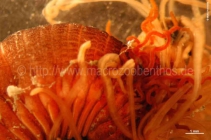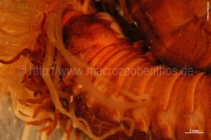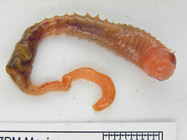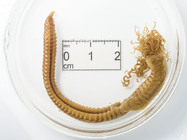Deep-Sea taxon details
Amphitrite Müller, 1771
129686 (urn:lsid:marinespecies.org:taxname:129686)
accepted
Genus
Amphitrite cirrata Müller, 1776 (type by subsequent designation)
- Species Amphitrite cirrata Müller, 1776
- Species Amphitrite fauveli Jirkov, Ravara & Cunha, 2018
- Species Amphitrite groenlandica Malmgren, 1866 represented as Neoamphitrite groenlandica (Malmgren, 1866) (superseded original combination)
marine, brackish, fresh, terrestrial
recent only
feminine
Müller, Otto Friedrich. 1771. Von Würmern des süssen und salzigen Wassers. 1-200. H. Mumme and Faber. Copenhagen., available online at https://www.biodiversitylibrary.org/page/14389400
page(s): 8, 188; note: established, intended for Spio cirrata König, which appears to be an unpublished name [details]
page(s): 8, 188; note: established, intended for Spio cirrata König, which appears to be an unpublished name [details]
Note The designation of type species is confused....
From editor or global species database
Type species The designation of type species is confused. Amphitrite cirrata is regarded as the type species, but strictly it was not named in 1771, when Müller used an unavailable name of Spio cirrata, and mentioned the available name used by Linnaeus of 'cirrosa' (for Nereis cirrosa). In 1777 Müller defined A. cirrata based on his 1771 usage and the Linnaean Nereis cirrosa, but he included five other Amphitrite species, so in 1777 A. cirrata could not be type species by monotypy, or by subsequent designation by Müller (although Müller uses it as the headline species). Nevertheless it is type by subsequent designation as subsequent authors used A. cirrata as the type species. [details]
Etymology not stated, but the derivation from the female ancient Greek personal name would be considered as obvious. From Wikipedia:...
Homonymy Amphitrite has been a popular genus name. Amphitrite Müller 1771 is apparently senior to the homonyms Amphitrite...
Nomenclature Amphitrite Müller 1771 appears to be derived for a pre-Linnaean species name, Spio cirrata [apparently unpublished but...
Etymology not stated, but the derivation from the female ancient Greek personal name would be considered as obvious. From Wikipedia: "Amphitrite (/æmfɪˈtraɪtiː/; Greek: Ἀμφιτρίτη) was a sea goddess and wife of Poseidon and the queen of the sea. Under the influence of the Olympian pantheon, she became the consort of Poseidon and was later used as a symbolic representation of the sea and the goddess of calm seas and safe passage through storms" [details]
Homonymy Amphitrite has been a popular genus name. Amphitrite Müller 1771 is apparently senior to the homonyms Amphitrite...
Homonymy Amphitrite has been a popular genus name. Amphitrite Müller 1771 is apparently senior to the homonyms Amphitrite Ascanius, 1774, Mollusca, accepted as Dendronotus Alder & Hancock, 1845, and Amphitrite De Haan, 1833, Decapoda [in De Haan, 1833-1850] accepted as Portunus Weber, 1795. There is also a kingdom Chromista Amphitrite. Note that if Amphitrite Müller was not valid until a species was added in 1776 then the Molluscan Amphitrite of 1774 has priority. [details]
Nomenclature Amphitrite Müller 1771 appears to be derived for a pre-Linnaean species name, Spio cirrata [apparently unpublished but...
Nomenclature Amphitrite Müller 1771 appears to be derived for a pre-Linnaean species name, Spio cirrata [apparently unpublished but evidently known to Müller and Linnaeus]. Code article 12.2.5. states "in the case of a new genus-group name, the use of one or more available specific names in combination with it, or clearly included under it, [makes the genus name available]." Müller mentions the variant 'cirrosa spelling of Linnaeus, and this name is available so perhaps the genus name is available from 1771. However, fide AnimalBase: Amphitrite was "Established without species included. Müller 1771: 188 referred to a name Spio cirrata attributed to König and argued that the Linnean name cirrosa (Nereis cirrosa Linné, 1767) was gramatically less correct. Müller 1771 did not use any of the two specific names as valid, in his own classification. Müller used a German name for the species and did not use Latin specific names. The fact that the two names were cited from other sources did not imply usage of these names (Art. 11.5.2)." See also further notes under the type species, Amphitrite cirrata. [details]
Read, G.; Fauchald, K. (Ed.) (2024). World Polychaeta Database. Amphitrite Müller, 1771. Accessed through: Glover, A.G.; Higgs, N.; Horton, T. (2024) World Register of Deep-Sea species (WoRDSS) at: https://www.marinespecies.org/deepsea/aphia.php?p=taxdetails&id=129686 on 2024-04-19
Glover, A.G.; Higgs, N.; Horton, T. (2024). World Register of Deep-Sea species (WoRDSS). Amphitrite Müller, 1771. Accessed at: https://marinespecies.org/deepsea/aphia.php?p=taxdetails&id=129686 on 2024-04-19
Date
action
by
original description
Müller, Otto Friedrich. 1771. Von Würmern des süssen und salzigen Wassers. 1-200. H. Mumme and Faber. Copenhagen., available online at https://www.biodiversitylibrary.org/page/14389400
page(s): 8, 188; note: established, intended for Spio cirrata König, which appears to be an unpublished name [details]
additional source Fauchald, K. (1977). The polychaete worms, definitions and keys to the orders, families and genera. <em>Natural History Museum of Los Angeles County: Los Angeles, CA (USA), Science Series.</em> 28:1-188., available online at http://www.vliz.be/imisdocs/publications/123110.pdf [details]
additional source Integrated Taxonomic Information System (ITIS). , available online at http://www.itis.gov [details]
additional source Bellan, G. (2001). Polychaeta, <i>in</i>: Costello, M.J. <i>et al.</i> (Ed.) (2001). European register of marine species: a check-list of the marine species in Europe and a bibliography of guides to their identification. <em>Collection Patrimoines Naturels.</em> 50: 214-231. (look up in IMIS) [details]
additional source Brunel, P., L. Bosse & G. Lamarche. (1998). Catalogue of the marine invertebrates of the estuary and Gulf of St. Lawrence. <em>Canadian Special Publication of Fisheries and Aquatic Sciences, 126.</em> 405 pp. (look up in IMIS) [details] Available for editors
additional source Hutchings, Patricia A.; Glasby, Christopher J. (1988). The Amphitritinae (Polychaeta: Terebellidae) from Australia. <em>Records of the Australian Museum.</em> 40(1): 1-60., available online at http://doi.org/10.3853/j.0067-1975.40.1988.150 [details] Available for editors
additional source Malmgren, Anders Johan. (1866? vol for 1865). Nordiska Hafs-Annulater. [part three of three]. <em>Öfversigt af Königlich Vetenskapsakademiens förhandlingar, Stockholm.</em> 22(5): 355-410, plates XVIII-XXIX., available online at https://biodiversitylibrary.org/page/32339631
page(s): 374-375 [details]
identification resource Jirkov, Igor A. (2020). Review of the European Amphitrite (Polychaeta: Terebellidae) with description of two new species. <em>Invertebrate Zoology.</em> 17(4): 311-360., available online at https://kmkjournals.com/journals/Inv_Zool/IZ_Index_Volumes/IZ_17/IZ_17_4_311_360
page(s): 316; note: key to European species [details]
page(s): 8, 188; note: established, intended for Spio cirrata König, which appears to be an unpublished name [details]
additional source Fauchald, K. (1977). The polychaete worms, definitions and keys to the orders, families and genera. <em>Natural History Museum of Los Angeles County: Los Angeles, CA (USA), Science Series.</em> 28:1-188., available online at http://www.vliz.be/imisdocs/publications/123110.pdf [details]
additional source Integrated Taxonomic Information System (ITIS). , available online at http://www.itis.gov [details]
additional source Bellan, G. (2001). Polychaeta, <i>in</i>: Costello, M.J. <i>et al.</i> (Ed.) (2001). European register of marine species: a check-list of the marine species in Europe and a bibliography of guides to their identification. <em>Collection Patrimoines Naturels.</em> 50: 214-231. (look up in IMIS) [details]
additional source Brunel, P., L. Bosse & G. Lamarche. (1998). Catalogue of the marine invertebrates of the estuary and Gulf of St. Lawrence. <em>Canadian Special Publication of Fisheries and Aquatic Sciences, 126.</em> 405 pp. (look up in IMIS) [details] Available for editors
additional source Hutchings, Patricia A.; Glasby, Christopher J. (1988). The Amphitritinae (Polychaeta: Terebellidae) from Australia. <em>Records of the Australian Museum.</em> 40(1): 1-60., available online at http://doi.org/10.3853/j.0067-1975.40.1988.150 [details] Available for editors
additional source Malmgren, Anders Johan. (1866? vol for 1865). Nordiska Hafs-Annulater. [part three of three]. <em>Öfversigt af Königlich Vetenskapsakademiens förhandlingar, Stockholm.</em> 22(5): 355-410, plates XVIII-XXIX., available online at https://biodiversitylibrary.org/page/32339631
page(s): 374-375 [details]
identification resource Jirkov, Igor A. (2020). Review of the European Amphitrite (Polychaeta: Terebellidae) with description of two new species. <em>Invertebrate Zoology.</em> 17(4): 311-360., available online at https://kmkjournals.com/journals/Inv_Zool/IZ_Index_Volumes/IZ_17/IZ_17_4_311_360
page(s): 316; note: key to European species [details]
 Present
Present  Inaccurate
Inaccurate  Introduced: alien
Introduced: alien  Containing type locality
Containing type locality
From editor or global species database
Diagnosis Branchiae 3, rarely 2, pairs from segment 2; dendritically branched or filiform arising from a basal stump or distinct stalk. Lateral lobes present on anterior segments. Notopodia from segment 4, 17-25 pairs; notosetae distally serrated. Neuropodia with uncini from segment 5 (Setiger 2) arranged in double rows in posterior thorax, either as an interlocking "zipper" or in 2 distinct rows. Nephridial papillae from segment 3. [details]Etymology not stated, but the derivation from the female ancient Greek personal name would be considered as obvious. From Wikipedia: "Amphitrite (/æmfɪˈtraɪtiː/; Greek: Ἀμφιτρίτη) was a sea goddess and wife of Poseidon and the queen of the sea. Under the influence of the Olympian pantheon, she became the consort of Poseidon and was later used as a symbolic representation of the sea and the goddess of calm seas and safe passage through storms" [details]
Grammatical gender Feminine, known as a Greek personal name, and as the name of a goddess. [details]
Homonymy Amphitrite has been a popular genus name. Amphitrite Müller 1771 is apparently senior to the homonyms Amphitrite Ascanius, 1774, Mollusca, accepted as Dendronotus Alder & Hancock, 1845, and Amphitrite De Haan, 1833, Decapoda [in De Haan, 1833-1850] accepted as Portunus Weber, 1795. There is also a kingdom Chromista Amphitrite. Note that if Amphitrite Müller was not valid until a species was added in 1776 then the Molluscan Amphitrite of 1774 has priority. [details]
Nomenclature Amphitrite Müller 1771 appears to be derived for a pre-Linnaean species name, Spio cirrata [apparently unpublished but evidently known to Müller and Linnaeus]. Code article 12.2.5. states "in the case of a new genus-group name, the use of one or more available specific names in combination with it, or clearly included under it, [makes the genus name available]." Müller mentions the variant 'cirrosa spelling of Linnaeus, and this name is available so perhaps the genus name is available from 1771. However, fide AnimalBase: Amphitrite was "Established without species included. Müller 1771: 188 referred to a name Spio cirrata attributed to König and argued that the Linnean name cirrosa (Nereis cirrosa Linné, 1767) was gramatically less correct. Müller 1771 did not use any of the two specific names as valid, in his own classification. Müller used a German name for the species and did not use Latin specific names. The fact that the two names were cited from other sources did not imply usage of these names (Art. 11.5.2)." See also further notes under the type species, Amphitrite cirrata. [details]
Type species The designation of type species is confused. Amphitrite cirrata is regarded as the type species, but strictly it was not named in 1771, when Müller used an unavailable name of Spio cirrata, and mentioned the available name used by Linnaeus of 'cirrosa' (for Nereis cirrosa). In 1777 Müller defined A. cirrata based on his 1771 usage and the Linnaean Nereis cirrosa, but he included five other Amphitrite species, so in 1777 A. cirrata could not be type species by monotypy, or by subsequent designation by Müller (although Müller uses it as the headline species). Nevertheless it is type by subsequent designation as subsequent authors used A. cirrata as the type species. [details]












